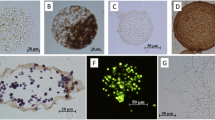Summary
Microbial, algal, plant and animal cells have been immobilized, with preserved viability, by entrapment in various matrices according to a new bead polymerization technique. The cell polymer/monomer mixture is kept suspended in a hydrophobic phase such as soy, paraffin, or silicon oil, tri-n-butylphosphate, or dibutyphtalate, which is compatible with the cells. The various monomers or polymers tested include agarose, agar, carrageenan, alginate, fibrin, and polyacrylamide. Furthermore, by adjustment of the stirring speed of the suspension, beads of desired diameter can easily be obtained. The entrapped cells are fully viable and biosynthetically active.
Similar content being viewed by others
References
Birmbaum S, Larsson P-O, Mosbach K (1983) Immobilized cells. In: Scouten W (ed) Solid phase biochemistry. John Wiley, New York
Brodelius P, Deus B, Mosbach K, Zenk MH (1979) Immobilized plant cells for the production and transformation of natural products. FEBS Lett 103:93–97
Brodelius P, Nilsson K (1980) Entrapment of plant cells in different matrices. A comparative study. FEBS Lett 122:312–316
Brodelius P, Nilsson K, Mosbach K (1981) Production of α-keto acids, part 1. Immobilized cells of Trigonopsis variabilis containing D-amino acid oxidase. Appl Biochem Biotechnol 6:293–308
Brodelius P, Mosbach K (1982) Immobilized plant cells. In: Laskin AI (ed) Advances in applied microbiology, vol 26. Academic Press, New York, pp 1–26
Brodelius P, Constabel F, Kurz WGW (1982) Viability and biosynthetic capacity of immobilized plant cells. In: Chibata I, Fukui S, Wingard L (eds) Enzyme engineering, vol 6. Plenum Press, New York, pp 203–204
Brodelius P, Nilsson K (1983) Permeabilization of immobilized plant cells, resulting in release of intracellularly stored products with preserved cell viability. Eur J Appl Microbiol Biotechnol 17:275–280
Cheetham PSJ (1980) Developments in the immobilization of microbial cells and their applications. In: Wiseman A, (ed) Topics in enzyme and fermentation technology, vol 4. Ellis Horwood, Chichester, pp 189–238
Gamborg OL, Miller RA, Ojima K (1968) Nutrient requirements of suspension cultures of soybean root cells. Exp Cell Res 50:151–158
Klein J, Kluge M (1981) Immobilization of microbial cells in polyurethane materices. Biotechnol Lett 3:65–70
Larsson P-O, Mosbach K (1979) Alcohol production by magnetic immobilized yeast. Biotechnol Lett 1:501–506
Martin CKA, Perlman D (1976) Conversion of L-sorbose to 2-keto-L-gulonic acid by mixtures of immobilized cells of Gluconobacter melanogenus IFO 3293 and Pseudomonas species. Eur J Appl Microbiol 3:91–95
Nilsson H, Mosbach R, Mosbach K (1972) The use of bead polymerization of acrylic monomers for immobilization of enzymes. Biochim Biophys Acta 268:253–256
Nilsson K, Mosbach K (1980) Preparations of immobilized animal cells. FEBS Lett 118:145–150
Nilsson K, Mosbach K (1982) Swedish Patent Application 8210041-0
Nilsson K, Scheirer W, Merten OW, Oestberg L, Liehl E, Katinger HWD, Mosbach K (1982) Entrapment of animal cells for the production of monoclonal antibodies and other biomolecules. Nature 302:629–630
Siegbahn N, Mosbach K (1982) An immobilized cyclic multi-step enzyme system — The urea cycle. FEBS Lett 137:6–10
Srere PA, Mattiasson B, Mosbach K (1973) An immobilized three-enzyme system. A model for microenvironmental compartmentation in mitochondria. Proc Natl Acad Sci USA 70:2534–2538
Szwajcer E, Brodelius P, Mosbach K (1982) Production of α-keto acids: 2. Immobilized whole cells of Providencia sp. PCM 1298 containing L-amino acid oxidase. Enzyme Microb Technol 4:409–413
Wikström P, Szwajcer E, Brodelius P, Larsson PO, Mosbach K (1982) Formation of α-keto acids from amino acids using immobilized bacteria and algae. Biotechnol Lett 4:153–158
Author information
Authors and Affiliations
Rights and permissions
About this article
Cite this article
Nilsson, K., Birnbaum, S., Flygare, S. et al. A general method for the immobilization of cells with preserved viability. European J. Appl. Microbiol. Biotechnol. 17, 319–326 (1983). https://doi.org/10.1007/BF00499497
Received:
Issue Date:
DOI: https://doi.org/10.1007/BF00499497




